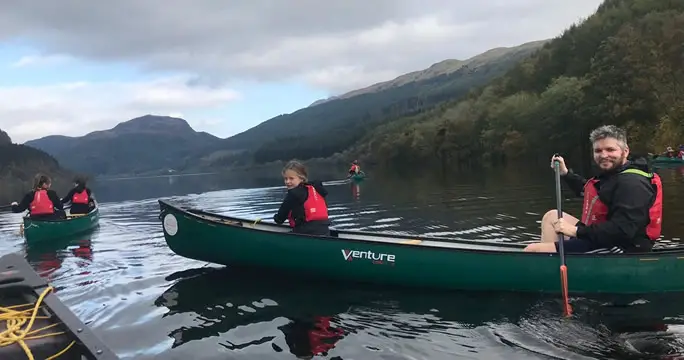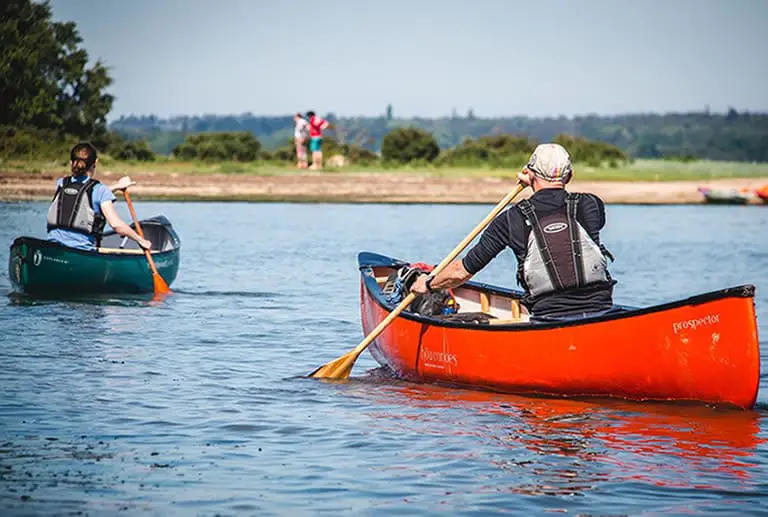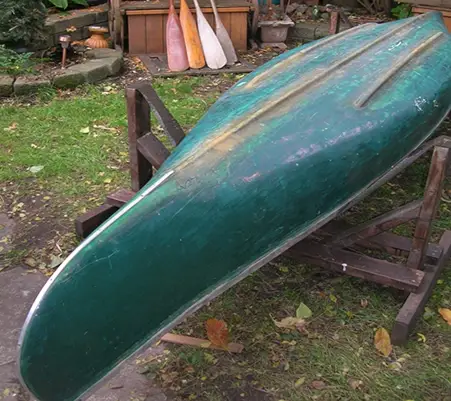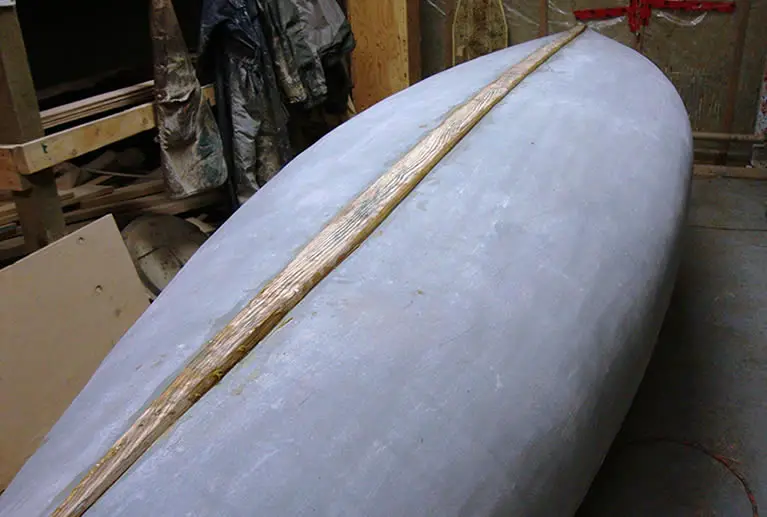Canoeing is a fun water activity that anyone from the experienced paddler to the novice can enjoy. But some people wonder if using a canoe with a keel is a better option than using a canoe without one. In the is battle of the boats article we look at the fat bottom canoe vs the keel canoe.
Contents
Flat Bottom Canoe vs Keel Canoe
Flat bottom canoes are excellent for shallow water use and offer superior stability in calm water, however they can be difficult to keep straight for novice paddlers.
Adding a keel to the canoe helps the boat to track straighter.
This is only an advantage to the complete novice paddler though as even an advanced beginners will have outgrown the need for one.
However, a keel can also protect the bottom of the boat from damage due to impacts with obstacles in shallow waters.
Keel or no keel – what’s the point?
Canoes come in different shapes and sizes.
The humble canoe has evolved greatly since it was first used thousands of years ago.

There are several different hull designs associated with the modern canoe with each being better suited to certain marine environments and activities.
I will cover this subject matter at the end of this article because it is very important.
If you are new to canoeing then I urge you not to skip that section.
Any one of the different canoe designs available can come with or without a keel.
You can also add your own keel to a canoe that does not have one if you wish.
Many people wonder why a canoe even has a keel. What is a keel used for on a canoe?
There are two basic reasons for having a keel on a canoe. They are:
- To help the boat track straighter.
- To protect the bottom of the hull.
How does this work?
Tracking straighter
For many people who are inexperienced paddlers trying to keep their canoe going forward in a straight line can be a challenge.
Using a one-bladed paddle on, what is, a fairly large boat can often prove to be difficult for the novice.
Unless you are a natural born paddler the chances are you will find it very difficult to make a canoe track straight in the beginning stages of your paddling experiences.
It takes time to perfect your paddling stroke to ensure your canoe keeps moving straightly and smoothly.
As you must complete one full stroke at one side of the boat before making a similar stroke at the other side you may find that your canoe veers to the side.
It will veer to the right as you you complete a stroke at the right side and will veer to the left when you complete a stroke on the left side.
On still water it is pretty easy to figure out how to stop this from happening after just a short amount of time on the water.
However, when you are in moving water with a current pushing the boat in a specific direction.

For example the current is pushing against the left side of your boat, you may find that your boat keeps getting pushed off course in the direction the current is moving in.
Fortunately though, with even adequate paddling technique you can can overcome this and this you can develop in fairly quick order.
However, in the beginning, when you are a complete novice, you may not have the experience needed to deal with the situation.
You should be aware though that there can be various reasons a paddler cannot get their boat to go straight and you should aquatint yourself with all of them (see our article on that here).
Although you will still need to adjust your paddling, a keel on the canoe will greatly help you keep the boat moving straight.
Adding a keel to a canoe well help the boat track much straighter which is an advantage to the novice paddler.
In most cases it can also help the canoe to move faster.
So, why don’t all canoes have keels?
Most canoes do not have keels because they are not considered necessary by experienced canoeists.
Even paddlers with only moderate experience will not need a keel, as they will have developed their paddling technique sufficiently to keep the boat straight without aid.
Keel canoes are great for novice paddlers to help them move straight but once they become accustomed to padding the keel soon becomes unnecessary.
Even moderately advanced beginners will not need one.
You do not even need to be considered a competent paddler before you will find that using a keel canoe is unnecessary.
After only a few hours on the water you will likely have developed enough proficiency at paddling to be able to keep your canoe tracking straight.
Paddling a canoe is not that difficult so a keel canoe is really not that necessary for helping to keep the canoe track straight.
However, a keel has another useful purpose on a canoe.
Hull protection
Having a keel on a canoe, especially a flat bottom canoe that is used in very shallow waters, is also a great hull-protection feature.
A keel is great for protecting your canoe from collision damage in shallow water.
A keel on the bottom of a canoe can act as a guard against collisions with obstacles and debris at the bottom of a river, lake or pond etc., that could potentially damage the boat.
The keel can help the canoe slide over obstacles much easier without causing any damage to the hull of the boat.
Even if damage does occur it will be to the keel and not the hull of the canoe. A canoe keel can be easily removed and replaced much easier than repairs can be made to the hull.
So, even if you do not think you do not need a keel to help you keep your canoe tracking straight it is a great feature to have on a flat bottom canoe if you intend to use it in skinny water.
See how easy it is to attach skid plates
Skid plates, also known as keel guards because they resemble a canoe keel, are an alternative option for hull protection and they have zero effect on the boat’s performance and are cheaper that attaching a canoe keel.
This is why so many canoeists will go with that option instead of attaching a keel.
A more important consideration than a keel
As you can see a keel canoe does have its place and can be useful for certain people and in specific environments.
However, there are much more important considerations for the novice canoeist than whether or not he/she needs a keel on their canoe.
A much more important consideration is what type of hull design you need your canoe to have.
The type of canoe you use is much more important than whether or not it has a keel.
As we covered in our canoe buyer’s guide choosing a canoe with the correct hull design for your specific needs is essential if you want to get the most put of your boat.
In fact, using the wrong type of canoe for some activities can even be dangerous regardless of whether the canoe has a keel or not!
Things to consider before you buy a canoe:
- Length.
- Width.
- Depth.
Not all canoes are the same size (take the freighter canoe for example) and some sit deeper in the water than others.

Most canoes with a keel will be canoes with the shallowest draft and thus will have a flat bottom. But not all canoes have a flat bottom.
You may find that you need a canoe that has a slight arch or “v” shape at its bottom thus making the need for a canoe keel unnecessary as the hull shape does the work a keel would do.
So choosing the correct hull type is more important than whether the canoe has a keel or not.
Canoes hull sides differ as follows:
- Straight Sides.
- Flared sides.
- Tumblehome.
Canoe hull bottoms differ as follows:
- Flat bottom.
- Round bottom.
- Shallow arch.
- Shallow-v .
Why is it important to get a canoe with the correct type of hull for your chosen canoeing activities?
Well, as I already mentioned using the wrong type of canoe for an activity can lead to a very uncomfortable experience or it can even be downright dangerous.
Two perfect examples of needing the correct canoe for the correct activity can be illustrated by looking at still water recreational canoeing and ocean canoeing.
For recreational use in still water a flat bottom canoe with straight sides will offer superior stability and tracking, even for the novice paddler, because it has superior primary stability.
However, this type of canoe would be dangerous to use in ocean water unless it was outfitted with outriggers, and even then it would be a poor choice.
For ocean canoeing a more round-sided canoe with a shallow arch bottom, or shallow-v bottom, would be a better choice.
This type of boat can handle the chop much better and would offer better secondary stability. (For an explanation of primary and secondary stability read this.)
Choosing the right canoe for the right activity, and the correct marine environment, can mean the difference between your canoe being easy to tip or difficult to tip.
Be sure to also read our comprehensive guide on the different hull types in this article and how they affect the performance of the canoe in different marine environments.

